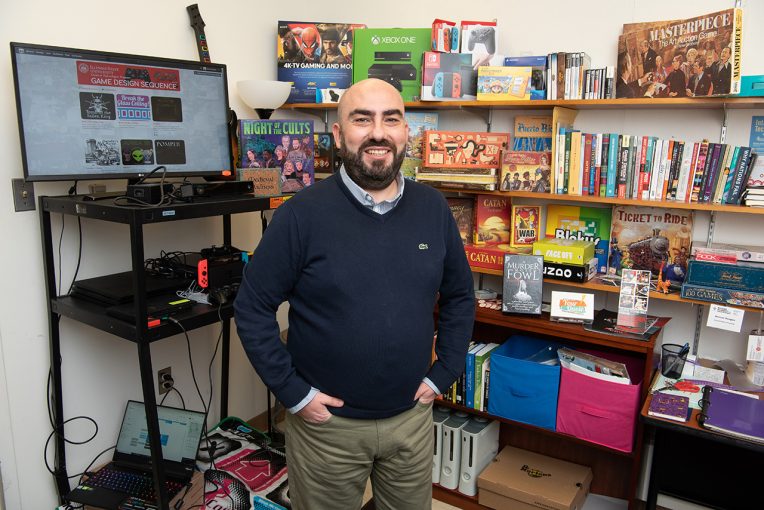Creating great video games requires close collaboration between people from seemingly disparate disciplines. How does a course teaching game design foster that kind of creative and collaborative environment during a pandemic? Dr. Sercan Sengun, assistant professor of creative technologies, tried to answer this question as he built his course work for the fall semester.
Sengun found the answer by blending external software and services with those already provided by Illinois State. He created a suite of videos in ReggieNet, Illinois State’s online learning platform, for students to watch and refer to later when working on their projects. He also maintains a forum within ReggieNet where he can answer questions for students or allow students to discuss the class among themselves.
“Because game design is collaborative, I have always been in the practice of creating communication platforms so that students can work together on their projects,” he said.
ReggieNet is critical in maintaining Sengun’s more structured course work, but students in these disciplines need a space to be creative. To help with this, he set up channels for each of his classes in the popular instant messaging and collaboration software Slack. In these communities, students share articles, memes, and videos; ask each other questions, and can easily get in touch with Sengun if they need assistance.
“They stay really formal in ReggieNet because it is still a school space,” Sengun said. “They don’t really share funny things and they keep their discussions mostly around course work. But as I move them into these other platforms, I have started seeing a lot more fun content.”
Sengun remains in contact with students he has taught in the past and encourages them to stay in the Slack channels after they move into more advanced classes or graduate. Former students are not only a great resource for current students as they work on their projects, but potential friends and future collaborators.
“The use of Slack and the forums has really given the class more of a sense of community,” said senior Rhiannon Kelly. “I think with this class I feel a little more connected to the class and there is a little bit more of a remnant of that in-person setting than with some of my other classes.”
There have also been efforts to keep people connected through mediums that have nothing to do with class. On Saturdays, students and faculty are invited to play online games together. Among Us, an online multiplayer game that has gotten popular during the pandemic, has been heavily played by creative technologies in recent days.
“I appreciate how much Sercan pushes us to go past the classroom, especially in an online semester,” said Mason Bates ’20, now a graduate student in creative technologies. “It can be hard to maintain classwork with just classwork and having a couple of extra areas to go is helpful.”
Another challenge Sengun faced was how to get student work out into the world and into the hands of players. Before the pandemic, Sengun and his students attended local conventions with working prototypes of games developed in Illinois State classrooms. Sengun set up an Illinois State page on itch.io, a popular game distribution community. Students can upload their games to the platform and users can download them to play. For traditional board and card games, files are available that can be downloaded, printed, and played. Sengun also uploads assets to Behance, a social platform designed to showcase creative work. Sengun also had his students create video essays that were uploaded to the creative technologies YouTube channel.
“Those games really need to be out there,” Sengun said. “Student work needs to be at competitions, at events, at showcases. We really want to support this as the school and the program. That is why we made this social media push toward putting the games out to the public.”
This increased level of communication and community building has been critical for students to stay engaged during the pandemic. Sengun believes that even when Illinois State begins to transition back to more in-person teaching and learning, this will be the new normal for instructors.
“This kind of instruction taught me a lot about student interaction, supporting students’ learning, and some shortcomings of my own material that I wasn’t even aware of myself,” he said. “So, when we revert to face-to-face in the future, I want to keep some of these practices myself. Even if it isn’t the students who demand it, I feel like this has been really useful for my classes.”
Sengun’s students appreciate him going the extra mile during an especially turbulent point in time. “He really cares about us and how we’re doing,” said junior Rafael Gonzales. “It is really nice to know that he understands that we might not be there in that moment and that our lives come first. It’s really nice to work with him as a professor.”
Apply now for fall 2021.

